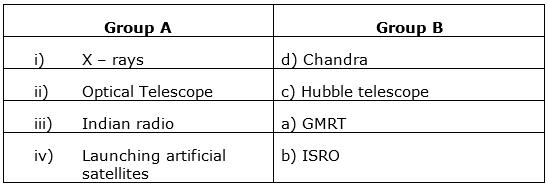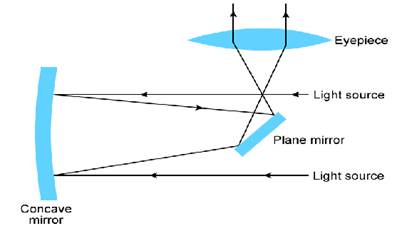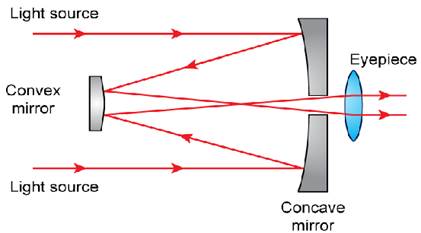Class 9 MAHARASHTRA STATE TEXTBOOK BUREAU Solutions Science Chapter 18 - Observing Space : Telescopes
Observing Space : Telescopes Exercise Exercise
Solution 1
a. The wavelength of visible light is between 400 nm and 800 nm.
b. GMRT is used for radio waves.
c. A certain X-ray telescope is named after scientist Subramanian Chandrashekhar.
d. The first scientist to use a telescope for space observation was
Galileo Galilei.
e. The biggest optical telescope in India is situated at Aryabhata Research Institute of Experimental Sciences, Nainital.
Solution 2

Solution 3
Difficulties faced in using ground-based telescopes due to which it does not make good quality observations are:
- Intensity of light rays reaching the Earth's surface decreases as some of the light is absorbed by atmosphere.
- The change in atmospheric pressure and temperature causes the light rays to change their path and this changes the position of image.
- We cannot use optical telescopes during day time because of the presence of sunlight. Even in night, city lights and cloudy weather can cause hindrance in observing heavenly bodies.
- To overcome these problems, telescopes are now being erected in space itself like:
- Hubble telescope: - It is an optical telescope launched by National Aeronautics and Space Administration in 1990.
- Chandra: - It is an X-ray telescope launched by National Aeronautics and Space Administration in 1999.
Solution 4
Construction and working of Newtonian telescope:
1. Light rays coming from the source are incident on a concave mirror.
2. These rays are deflected by a small plane mirror before they converge to a focus.
3. Thus, the rays are focused at the point lying perpendicular to the axis of the telescope.
4. Then the rays pass through the eyepiece through which a magnified image is obtained.

Construction and working of Cassegrain Telescope:
1. Light rays coming from a source are incident on a concave mirror.
2. On reflecting, these rays are again reflected back by a convex mirror.
3. Reflecting rays pass through the hole at the centre of a concave mirror.
4. These rays pass through the eyepiece which is placed behind a concave mirror.

Solution 5
a. Newtonian telescope

b. Both plane and spherical mirror is used in this telescope. The spherical mirror is a concave mirror.
c. Cassegrain telescope also uses a curved mirror.
d. Light rays coming from a body at space get reflected by the concave mirror. Before the reflected rays converge at focus of the concave mirror, it is again reflected by plane mirror. Thus, the rays pass through the eyepiece and we get a magnified image of body.
Solution 6a
Galileo constructed a telescope which provides an erect image of an object only with help of two lenses.
The Galileo's telescope is consists of two lenses located at the ends of a long tube. The objective was convex lens and eye piece was a concave lens.
Solution 6b
i. Heavenly bodies emit radio waves in addition to visible radiation. Such radiations are not visible to our eyes. Hence, a special type of telescope is used to receive these rays which is called radio telescope.
ii. It is made from one or more dishes of a particular parabolic shape. In optical telescope the incident radio waves are reflected by these dishes and converge at the focus.
iii. A radio receiver is placed at the focal point.
iv. The information gathered by this receiver is passed on to a computer which analyses it and constructs an image of the source.
Solution 6c
- Intensity of light rays reaching the Earth's surface decreases as some of the light is absorbed by the atmosphere.
- The change in atmospheric pressure and temperature cause the light rays to change their path slightly and thus, shake the position of the image.
- We cannot use optical telescopes during day time due to presence of sunlight.
- Even in night, city light and cloudy weather can cause hindrance in observing the heavenly bodies.
- Thus, optical telescopes are located in uninhabited places on mountains.
Solution 6d
The Earth's atmosphere block all the X-rays either from earth to space or from space to earth.
Thus, we use radio waves in satellite communication.
Thus, X-ray telescope cannot be based on the earth.

